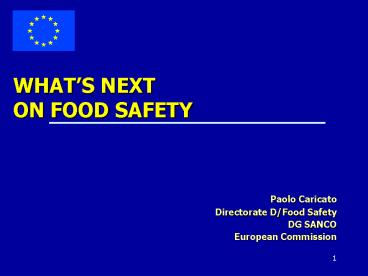Paolo Caricato PowerPoint PPT Presentation
1 / 27
Title: Paolo Caricato
1
WHATS NEXT ON FOOD SAFETY
- Paolo Caricato
- Directorate D/Food Safety
- DG SANCO
- European Commission
2
WHATS NEXT ON FOOD SAFETYSAFER FOOD FOR A
HEALTHIER DIET
3
- 1. Open chantiers on food safety
- 2. New instruments for better implementation
- 3. Completion of the White Paper on Food Safety
- 4. Healthier Diet
4
OPEN CHANTIERS ON FOOD SAFETY
- Zoonoses
- Microbiological criteria
- Contaminants
- Hygiene
- Pesticides
- Residues
5
ZOONOSES
- Division North/South MS
- Salmonella and Campylobacter most common
food-borne zoonoses - 2002 145.000 human cases salmonellosis and
149.000 campylobacteriosis notified through EU
reporting system - France each year about 30000 cases, about 7000
cases needed hospitalisation, more than 100
deaths
6
Estimated sources of human salmonellosis
- 39 eggs
- 25 pigs
- 21 chickens
- 11 cattle
- 4 other sources
7
MICROBIOLOGICAL CRITERIA
- New legislation on Salmonella Listeria,
Staphylococcies, E. Coli 2nd quarter 2005 - Fixation of limits analytical methods
- Actions by operators in case of non respect of
criteria - - corrective measures
- - withdrawal from market in certain cases
8
MICROBIOLOGICAL CRITERIA
9
MICROBIOLOGICAL CRITERIA
10
MICROBIOLOGICAL CRITERIA
11
FOOD HYGIENE
- Implementing measures by 1.01.2006
- - HACCP / Small businesses
- - Technical measures - safety of meat
(parasites)
12
FOOD HYGIENE Reg. 852/2004
- all food (replaces 93/43/EEC)
- ? stable to table (integrated approach)
- ? all stages of production, processing,
distribution, exports - primary responsibility food business
operator - general implementation of procedures based
on HACCP principles
13
FOOD HYGIENE Reg. 852/2004
- registration of all food businesses
- hygiene requirements for all food
premises - HACCP
- guides to good practice
- ? microbiological criteria
- ? temperature control requirements
14
FOOD HYGIENE Reg. 853/2004
- ? food of animal origin red and white meat,
farmed and wild game, MSM, meat products, live
bivalve molluscs, fishery products, raw milk
dairy products, eggs ( products), frogs
legs, snails, gelatins, collagen - ? flexibility
15
FOOD HYGIENE Reg. 853/2004
- ? registration/approval of establishments
- ? identification mark by operator
- ? health mark by competent Authorities
- ? HACCP based
- imports from approved third Country/establishme
nts
16
FOOD HYGIENE Reg. 854/2004
- Audits on HACCP based procedures
- ? checks on food chain information
- ? establishment operator responsibility
- ? verification by competent authority
- ? microbiological criteria
- ? traceability of products
17
FOOD HYGIENE Reg. 854/2004
- Imports procedures
- ? lists of third Countries
- ? approved production areas for bivalve
molluscs - ? specific rules for fishery products
- ? specific health certificates
18
THE FUTURE
- Repealing of legal texts under the Regulations
- ? 15 Commission Decisions preserved
- ? 37 Decisions will be repealed
- ? 13 Decisions will be modified
- ? 87 new Decisions will be taken as
implementing measures - ? Commission Regulation on microbiological
criteria
19
NEW INSTRUMENTS FOR BETTER IMPLEMENTATION
- Food and Feed Control Regulation
- Training
- BIPs
- Testing and Labs
- Worldwide RASFF
20
- Training Centre
- - communication better training for safer
food end 2005 - BIPs
- - improve control of the BIPs
- - options vary from stronger coordination to
a EC BIPS system - Testing and Labs
- - reinforce existing CRLs
- - create one CRL for all areas
- (eg pathogenic agents, feedingstuffs)
21
- Worldwide RASFF
- gt promote a RASFF to other regions of the
world - (1) help developing countries to set up a
system equivalent to ours - (2) interconnect existing systems
22
COMPLETION OF WHITE PAPER FOOD SAFETY
- Additives
- Enzymes
- Flavourings
- Packaging
- - innovative packaging
- - plastics
23
HEALTHIER DIET
- Nutritional health claims
- Fortification
- Nutrition labelling
- General revision of the labelling
24
Healthier diet
- Four key initiatives
- Nutrition and health claims new Regulation to
allow science-based messages regarding health
benefits of foods/diets define nutrient content
claims - Addition of nutrients to foods new legislation
to harmonise national rules on voluntary addition
of vitamins and minerals. - Nutrition labelling revision of current rules
to facilitate consumer understanding and
selection of healthy diets - Food labelling evaluation how can legislation be
improved to better address consumer needs?
25
Nutritional health claims
- Nutrition claims
- Low fat (less 3/100 gr), fat free (less 0,5/100
gr) - High fibre (more 6/100 gr)
- Health Claims
- 1) Role of nutrient well established Vit.A
improves vision, Vit.D fortifies your bones,
fibres facilitate intestinal transit - 2) Reduction of a disease risk Calcium reduce
risk of osteoporosis, fruit and vegetable reduce
risk of certain cancers - NO Generic, psychological behavioural claims
purifies your organism, reduce stress, help in
your exam - Nutrient profile
- Restriction on the use of claims for products
according to the content of certain nutrients
such as fats, sugars and salt
26
Nutrition labelling
- Nature of the present labelling scheme
- Nutrition labelling is voluntary
- It becomes compulsory when a nutrition claim is
made - Nutrition labelling should
- Become compulsory
- Or
- Remain Voluntary?
- If nutrition labelling became compulsory which
elements should be declared? - Energy
- Fat
- Saturates
- Carbohydrates
- Sugars
- Salt/sodium
27
Do we need a clearer labelling?
- Balance between request for more information on
label and need to have clear and meaningful
labels - EC rules only for packaged food
- Non pre-packaged Member States
- What about cantines restaurants nothing
- (Up to 30 of our meals outside home)
- Indication of origin? Now is only for fruits and
vegetables, beef, fish, eggs and GM - List of ingredients for alcoholic beverages?
- Misleading statements? Such as fresh,
traditional, homemade, pure, natural

